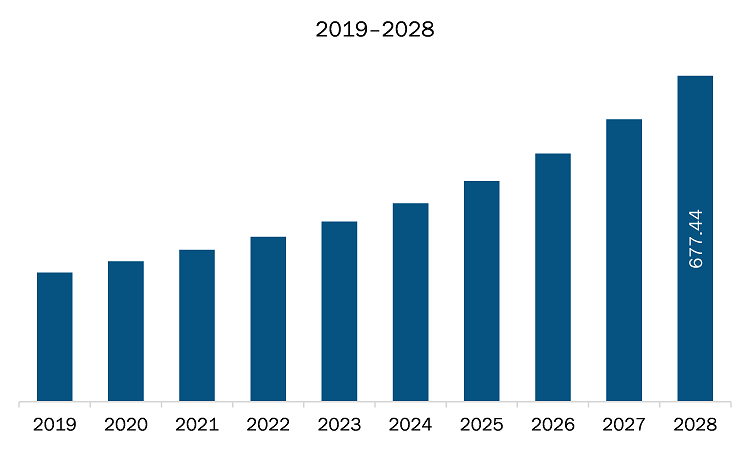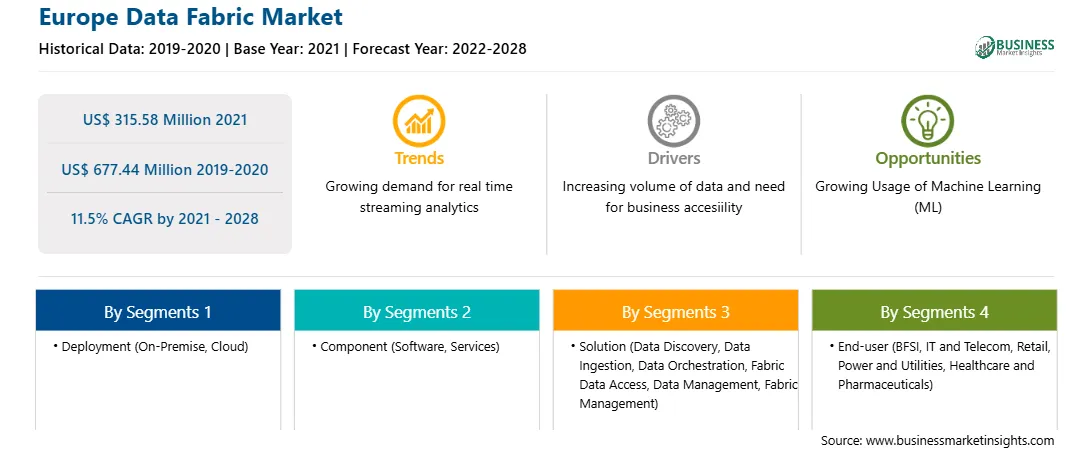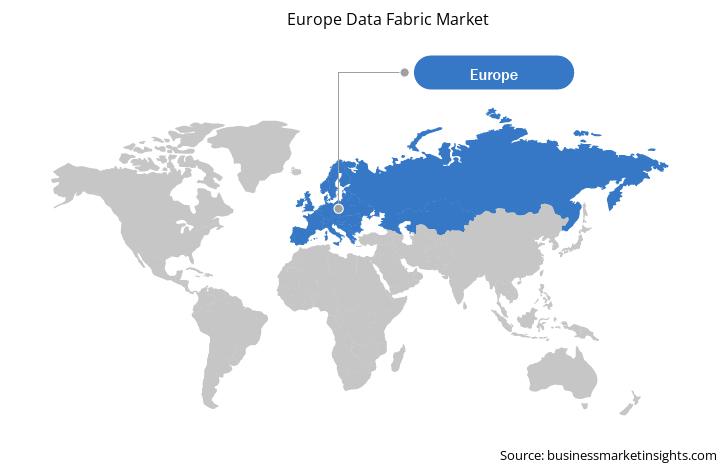Market Introduction
Germany, France, the UK, Russia, and Italy are among the major countries in Europe. The banking sector in the region faces various challenges such as rising regulations, increasing competition, and changing customer behavior. These factors force the sector to adopt digital technologies to compete in the market. The banking sector in Europe is highly adopting big data analytics solutions to maximize business performance. The technology help industry enhance retention, improve discounting, and segment their customer base to efficiently acquire new customers. As technology is evolving, devices, such as smartphones and tablets, to initiate transactions are also proliferating, making a notable rise in transaction. In the banking industry, big data analytics help understand the customer behavior in terms of the inputs received from numerous insights that comprises shopping trends, investment patterns, investment motivation, and financial background. Thus, owing to the huge significance of big data analytics, the demand for data fabric solutions is likely to surge across Europe in the coming years.
In 2020, the impact of COVID-19 differed from country to country across the European region as selected countries witnessed an increase in the number of recorded cases and subsequently attracted strict and longer lockdown periods or social isolation. However, Western European countries such as Germany, France, Russia, the UK, and others have seen a comparatively modest decrease in their growth activities because of the robust healthcare system. To protect its citizens from the virus, the European government has made tremendous investments in incorporating technologies in its healthcare systems to help identify signs of the virus. Further, in 2021, the offices are operating fluently with the uplifting of lockdown and ongoing vaccination process. Almost every industry has been negatively impacted in COVID-19 pandemic. However, the software industry is not affected as other industries, since businesses allowed their employees to work from home. Due to work from home facility, have resulted in the rise of quantity and variety of business data, the rise in need for business agility and data accessibility, and increasing demand for business analytics, contributing to the positive growth of the data fabric market in the region.
Strategic insights for the Europe Data Fabric provides data-driven analysis of the industry landscape, including current trends, key players, and regional nuances. These insights offer actionable recommendations, enabling readers to differentiate themselves from competitors by identifying untapped segments or developing unique value propositions. Leveraging data analytics, these insights help industry players anticipate the market shifts, whether investors, manufacturers, or other stakeholders. A future-oriented perspective is essential, helping stakeholders anticipate market shifts and position themselves for long-term success in this dynamic region. Ultimately, effective strategic insights empower readers to make informed decisions that drive profitability and achieve their business objectives within the market. The geographic scope of the Europe Data Fabric refers to the specific areas in which a business operates and competes. Understanding local distinctions, such as diverse consumer preferences (e.g., demand for specific plug types or battery backup durations), varying economic conditions, and regulatory environments, is crucial for tailoring strategies to specific markets. Businesses can expand their reach by identifying underserved areas or adapting their offerings to meet local demands. A clear market focus allows for more effective resource allocation, targeted marketing campaigns, and better positioning against local competitors, ultimately driving growth in those targeted areas.
Europe Data Fabric Strategic Insights

Europe Data Fabric Report Scope
Report Attribute
Details
Market size in 2021
US$ 315.58 Million
Market Size by 2028
US$ 677.44 Million
Global CAGR (2021 - 2028)
11.5%
Historical Data
2019-2020
Forecast period
2022-2028
Segments Covered
By Deployment
By Component
By Solution
By End-user
Regions and Countries Covered
Europe
Market leaders and key company profiles
Europe Data Fabric Regional Insights

Market Overview and Dynamics
The data fabric market in Europe is expected to grow US$ 315.58 million in 2021 to US$ 677.44 million by 2028; it is estimated to grow at a CAGR of 11.5% from 2021 to 2028. Increase in the internet usage and rise in the several connected devices, such as smartphones, laptops, tablets, and computers, directly increase the quantity and variety of business data. For instance, for monitoring purposes, cameras and sensors are used to continuously gather location data. The increasing need to drive meaningful insights from the gathered data fuels the adoption of data analytics among businesses. For analytics purpose, the data is extracted from data fabric. Further, while analyzing, data fabric integrates data from structured, semi-structured, and unstructured data sets. The variety of business data and the quantity of the data sets are increasing day-by-day due to the evolution of digitalization across several business organizations. For instance, according to Domo’s Eighth-Annual Data, in every minute of every day, consumers spend US$ 1 million online, make 1.4 million video and voice calls, share 150,000 messages on Facebook, and stream 404,000 hours of videos on Netflix. Thus, collective data that needs to be managed is in a huge quantity. Therefore, the data fabric is used for data management. Data fabric helps integrate data from various sources, store large amounts of data, and analyze it seamlessly in one place. Therefore, the demand for data fabric market is growing for gathering business information.
Key Market Segments
In terms of deployment, the cloud systems segment accounted for the largest share of the Europe data fabric market in 2020. In terms of component, the software segment accounted for the largest share of the Europe data fabric market in 2020. In terms of solution, the data management segment accounted for the largest share of the Europe data fabric market in 2020. In term of end-user, BSFI segment held a larger market share of the data fabric market in 2020.
Major Sources and Companies Listed
A few major primary and secondary sources referred to for preparing this report on the data fabric market in Europe are company websites, annual reports, financial reports, national government documents, and statistical database, among others. Major companies listed in the report are Denodo Technologies; IBM Corporation; Informatica LLC; NetApp, Inc.; Oracle Corporation; SAP SE; Software AG; Teradata; K2View; and Hewlett Packard Enterprise Development LP among others.
Reasons to buy report
Europe Data Fabric Market Segmentation
Europe Data Fabric Market – By Deployment
Europe Data Fabric Market – By Component
Europe Data Fabric Market – By Solution
Europe Data Fabric Market – By
End-user
Europe Data Fabric Market – By
Country
Europe Data Fabric Market – Companies Mentioned
The Europe Data Fabric Market is valued at US$ 315.58 Million in 2021, it is projected to reach US$ 677.44 Million by 2028.
As per our report Europe Data Fabric Market, the market size is valued at US$ 315.58 Million in 2021, projecting it to reach US$ 677.44 Million by 2028. This translates to a CAGR of approximately 11.5% during the forecast period.
The Europe Data Fabric Market report typically cover these key segments-
The historic period, base year, and forecast period can vary slightly depending on the specific market research report. However, for the Europe Data Fabric Market report:
The Europe Data Fabric Market is populated by several key players, each contributing to its growth and innovation. Some of the major players include:
The Europe Data Fabric Market report is valuable for diverse stakeholders, including:
Essentially, anyone involved in or considering involvement in the Europe Data Fabric Market value chain can benefit from the information contained in a comprehensive market report.